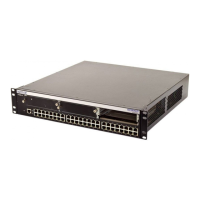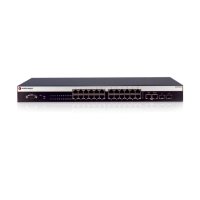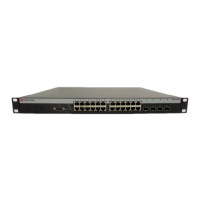Configuring Load Sharing Network Address Translation (LSNAT) show ip slb serverfarms
19-6 LSNAT Configuration
show ip slb serverfarms
Usethiscommandtodisplayserverloadbalancingserverfarminformation.
Syntax
show ip slb serverfarms [detail | serverfarmname [detail]]
Associate a virtual server with a server farm. serverfarm (“serverfarm (Virtual Server)” on
page 19-22)
Configure a virtual server IP address (VIP). virtual (“virtual” on page 19-22)
Enable a virtual server for service. inservice (“inservice (virtual server)” on
page 19-24)
(Optional) Restrict access to specific virtual server clients. client (“client” on page 19-24)
(Optional) Specify the type of session persistence and
timeout. Default is TCP. (See “Session Persistence” on
page 19-2 for more information.)
persistence level (“persistence level” on
page 19-25)
(Optional) Allow specific clients direct access to a real
server without using LSNAT.
allow accessservers (“allow accessservers” on
page 19-27)
Configure global direct access:
(Optional) Allow all clients to directly access all services
provided by real servers, EXCEPT FOR those services
configured to be accessed through a configured virtual
server. (See “Configuring Direct Access to Real Servers”
on page 19-3 for more information.)
ip slb allowaccess_all (“ip slb allowaccess_all”
on page 19-28)
Display or clear server load balancing connections and statistics:
(Optional) Display server load balancing connections and
statistics.
show ip slb conns (“show ip slb conns” on
page 19-29)
show ip slb stats (“show ip slb stats” on
page 19-30)
(Optional) Display SLB active sticky persistence
connections.
show ip slb sticky (“show ip slb sticky” on
page 19-31)
(Optional) Clear server load balancing connections or
statistics.
clear ip slb (“clear ip slb” on page 19-32)
Display and set chassis-based LSNAT limits:
(Optional) Display and set chassis-based LSNAT address
translation limits, from the switch CLI.
Note: These commands must be executed from the
switch CLI.
show router limits (“show router limits (LSNAT)”
on page 19-32)
set router limits (“set router limits (LSNAT)” on
page 19-33)
clear router limits (“clear router limits (LSNAT)”
on page 19-34)
Table 19-1 LSNAT Configuration Task List and Commands (continued)
Task Use these commands...

